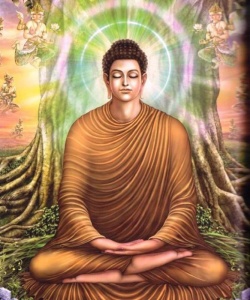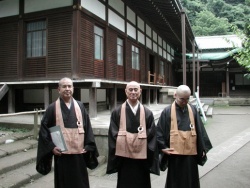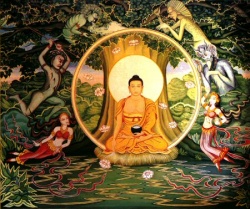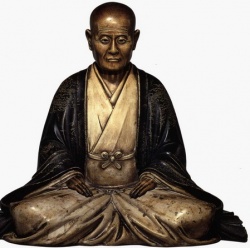Sila & bhavana
Wisdom Concentration Noble Eightfold Path Morality Right Speech Right Action Right Livelihood Just as a high rise building needs a strong foundation, all efforts towards higher spiritual achievement must begin with Sila (Morality) which enables the mind to be calm and easily focused. Without virtue, mental cultivation (Samadhi) and wisdom (Panna) are not attainable. Precepts
Sila (Buddhist Morality) Buddhist morality is based on the universal law of cause and effect. An act is ‘good’ or ‘bad’ according to the manner it affects oneself and others. All other criteria are misleading. Lay Buddhist morality as embodied in the Five Precepts may be considered at two levels:
1. It enables men to live together with mutual trust and respect.
2. It is the starting point for the spiritual journey towards Liberation and this is emphasised by the Buddha.
The Five Precepts (Panca Sila) Observance of precepts insures a person against the risk of being reborn into states of suffering and woe. The Precepts serve two purposes:
act as a barrier to evil mental impulses and deeds
prevent a person from generating bad Kamma.
They are the basic rules of mental and spiritual hygiene, the antidote against the poison of evil deeds. 1st 2nd 3rd 4th 5th
Pãnãti-pãtã veramani sikkhã padam samãdiyãmi Adinnã-dãnã veramani sikkhã padam samãdiyãmi Kãmesu micchã-cãrã veramani sikkhã padam samãdiyãmi Musãvãdã veramani sikkhã padam samãdiyãmi Surã meraya-majja-pamã-datthãnã veramani sikkhã padam samãdiyãmi I take the precept to abstain from destroying living beings. I take the precept to abstain from taking things not given. I take the precept to abstain from sexual misconduct. I take the precept to abstain from false speech. I take the precept to abstain from taking anything that causes intoxication or heedlessness. Observing Five Precepts
First Precept : Pãnãti-pãtã veramani sikkhã padam samãdiyãmi I undertake the training rule to abstain from killing living beings. This precept is to control anger and to develop loving-kindness such that a person regards and respects the lives of other beings as his own. Due to improper understanding, many people feel that they are unable to observe this precept at all times. This precept is not a commandment which forbids a person from killing at all costs. It is only a vow a person takes voluntarily based on the Buddha’s advice that to restrain from killing will generate good results. Questions often asked: Can I kill a mosquito? Can I kill the white ants in my house? Must I become a vegetarian? Should I join the army?
Second Precept : Adinnã-dãnã veramani sikkhã padam samãdiyãmi I take the training rule to abstain from taking things not given. This precept is aimed at controlling desire for material possessions and cultivating generosity. There are many forms of commiting theft: Stealing; Robbery; Swindling Exploitation of employees Ruthlessly driving competitors out of business Accepting bribes and trade on their influence Manipulating the market; creating artificial shortages A Buddhist may acquire wealth but through honest means. He should also use the wealth properly.
Third Precept : Kãmesu micchã-cãrã veramani sikkhã padam samãdiyãmi I undertake the training rule to abstain from sexual misconduct. Kamesu micchacara is sexual misconduct or adultery. The offence is that of taking sexual pleasure from a woman who is under protection of her parents and guardians or is the wife of another man. Kamesu also signifies excessive sensual indulgence of any kind. All sexual desires are rooted in craving and passion; they are, in fact, the strongest and most difficult to eradicate. Sex is one of the fundamental passions, common to all sentient beings in the human and animal worlds.
Fourth Precept : Musãvãdã veramani sikkhã padam samãdiyãmi I undertake the training rule to abstain from false speech. This precept stresses the importance of truthfulness and the need to control cowardice and illwill, the chief causes of false speech. The man who is addicted to lying, slander and back-biting destroys his friendships and his own reputation. Habitual liars become unable to distinguish truth from falsehood that in the end his whole outlook and judgment become distorted. The man who upholds the truth strengthens his character and reasoning powers and is more readily able to acquire penetrative insight into the nature of reality and understanding.
Fifth Precept : Surã meraya-majja-pamã-datthãnã veramani sikkhã padam samãdiyãmi I undertake the training rule to abstain from intoxicating drinks and drugs causing heedlessness This precept is aimed at controlling the craving for unwholesome excitement and cultivating mindfulness. Under the influence of drink, a man may break all the precepts without even realizing at the time that he is doing so. Besides that the alcoholic or drug addict will stop at nothing to obtain the means of satisfying their craving.
The Eight Precepts – Attanga Sila On Uposatha days, the Buddhist layman observes eight precepts. These are vows of a mildly ascetic nature whose purpose is to subdue the senses and strengthen the will.
The Eight Precepts begins with the same Five Precepts with the exception of the third. Instead of abstaining from sexual misconduct, it becomes, “Abrahmacariya veramani sikkhapadam samadiyami – I take the training rule to abstain from sexual pleasure of any kind.” Precepts
Sixth Precept : Vikala-bhojana veramani sikkhã padam samãdiyãmi I undertake the training rule to abstain from taking food at an unsuitable time. The lay devotee temporarily adopts the rule of the Bhikku Sangha in regard to food, by restricting himself to one meal or two taken before midday. It is a prescription against the over indulgence of appetite which tends to dull the mind and is not conducive to study and meditation.
Seventh Precept : I undertake the training rule to abstain from dancing, singing, music and unseemly shows; from the use of perfume; garlands and ungruent and from bodily adornments. This precept is concerned with the purification of the mind. Craving arises from contact between objects and the organ of sense. To control this craving, Buddhism urges us to abstain from frivolous pleasures and self-beautification. Nacca gita vadita visukadassana mala gandha vilepana dharana mandana vibhusanatthana veramani sikkhapadam samadiyami.
Eight Precept : I undertake the training rule to abstain from using high and luxurious couches. In old days, the more luxurious and elaborate beds were built very high. The high couch symbolises pride while its luxury stands for every kind of uncontrolled self-indulgence. Uccasavana-mahasavana veramani sikkhapadam samadiyami. By observing the 8 th precept, he does not make himself superior to others by outward show.
Bhavana – Meditation or Mental Culture Within each of us lies the vast potential to grow, to expand, to fulfil ourselves. This process of change is not the result of chanting the right prayers, reading the right books or believing in some religious formula. Real change goes deeper. To develop oneself, a person has to come to know himself, to experience all the hidden parts – good or bad – of his mind. This self-knowledge and realization, the basis for further development, comes from the practice of meditation or mental culture.
Why Meditate? Meditation is central to Buddhism, to our own spiritual growth and evolution to develop higher levels of consciousness. These higher levels of consciousness are characterised by the presence of ‘skilful mental states’ and the absence of ‘unskilful states’. ‘ Skilful mental states’ are those based on charity, loving-kindness and ‘unskilful states’ are rooted in greed, hatred and delusion.
The Process of Transformation
The experiences of different individuals differ in meditation. However, the process can be classified into three stages: Concentration Absorption Insight
The Process of Transformation Concentration Beginners of meditation have difficulties in concentrating on the object of meditation. Their mind is like a monkey, jumping from one thought to another thought. The mind is always thinking about the past or the future but seldom on the present resulting in our energy being scattered and wasted. So, the first stage of meditation is the development of concentration which enables the mind to focus on the object of meditation. Then we have achieved what we call horizontal integration . I need to see my girlfriend tomorrow. It is her birthday. What shall I get for her? I don’t have money now……
The Process of Transformation Absorption (Jhana) The next task is to achieve vertical integration by harmonising the energies of the gross and subtle aspects of the mind. This is much harder to achieve than horizontal integration. Once achieved, the meditator has started to go beyond the stage of concentration, and embark on the stage of absorption. The ‘absorption’ refers to higher states of consciousness than those we usually experience. For simplicity, we can broadly divide those higher levels into four ascending levels. Each higher level develops out of the previous lower level.
The Process of Transformation Absorption (Jhana) Levels The mind is so positive that you cannot be affected by anything negative. The mind is so positive and concentrated that it can affect the environment, even acting at a distance in supernatural ways. Level of radiation Fourth This level is likened to a bed of lotuses growing in the water, totally soaked and saturated by water. You experience the creative energy not as bubbling up within you but as saturating your entire being. Level of saturation Third The mind is likened to a pool of water which is constantly refreshed by an underground spring. One feels in contact with a fresh spring of creative energy. There is no more discursive mental activity.
Level of inspiration Second One feels happy and bouyant emotionally; complete absence of stray thoughts, although there may be some discursive mental activity. Level of Integration First Level
The Process of Transformation Insight The Fourth Jhana Level should not be the ultimate goal of spiritual life even though it is very blissful. The process of self-transformation must be taken to a higher level so that the underlying causes of unhappy states of mind can be removed. It is only by developing insight into reality that one finally uproots the causes of one’s suffering forever. With a mind refined, powerfully focussed and purified, one turns to the contemplation of reality itself, using the Buddha’s teaching about the nature of Reality.
The Process of Transformation Insight The development of insight is an overpowering experience which transforms a person’s whole being. At first insight comes in glimpses. Subsequently these glimpses become more prolonged, until finally the mind of the meditator dwells permanently in the radiant state of illumination, marked by the complete flowering of the qualities of Wisdom and Compassion.
Meditation Methods Meditation is a systematic development and culture of positive states of mind. There are several meditation practices and they are all designed with the objective of eradicating negative emotion. Mindfulness of Breathing This is the most fundamental of all Buddhist meditations. It is a concentration exercise and is traditionally the antidote to restlessness, anxiety and worry. The main effect of this practice is integration: to harmonize and collect all the different energies and focus them. This method can also lead to insight into the true nature of things.
Meditation Methods Vipassana (Insight) Meditation This meditation technique is based on the important teaching of the Buddha called the Satipatthana or Mahasatipattana Sutta . This discourse teaches the Four Foundations of Mindfulness – mindfulness of body, feelings, mental states and mental objects. The ultimate aim of Vipassana meditation is to understand the Three Characteristics of Life (Anicca, Dukkha, Anatta) and to realize the Four Noble Truths.
Meditation Methods Metta Bhavana Meditation This can be translated as the Development of Universal Loving-Kindness or Unlimited Friendliness. Through this practice we gradually develop feelings of warmth, friendliness and wishing well for ourselves (for charity begins at home), for those who are close to us, and by degrees, to everything that lives.
The gift of Dhamma excels all gifts the taste of Dhamma excels all taste, the delight in dhamma excels all delights, The Craving-Freed vanquishes all suffering.





